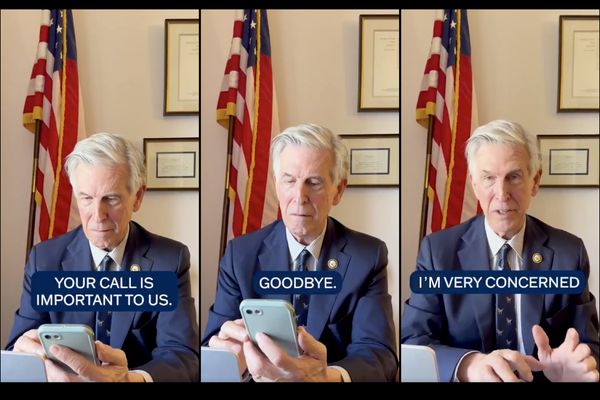
Gerald O’Brien lived a very public life – he was a New Zealand MP, anti-war activist and president of the World Peace Council, but not even those closest to him knew of his secret, all-consuming lifelong art project, which resulted in a vast and complex imaginary world.
Hidden in the late politician’s basement were O’Brien’s hand-painted and written imaginings, obsessively created from the time he was a toddler through to his years in parliament and beyond.
Until O’Brien’s family began clearing out his Wellington house after his death in 2017, his intricate work had been concealed from the world – including his wife of 60 years, Fausta.
“The whole thing is a mystery and nobody knew anything about it,” his nephew Lucien Rizos tells The Guardian. “How complete a picture he created overall, from such an early age, is sort of incomprehensible.”
Inside the many chaotic drawers and boxes of O’Brien’s basement, Rizos unearthed cut-outs of 700 or more characters, all meticulously painted, with individual outfits and facial features.

Each were given names or titles – some, such as King Charles III of Escotia and Fidel Bistro, were influenced by the real world; others, including H.R.H Prince Jupiter Squashyspeck and Katesmart Bigglesbum, were more inventive. As O’Brien aged, so too did his project, and while his style retained an artistic consistency, his rendering became more sophisticated and the stories more elaborate.
“The continuation of the magnificent illustrations go way into his adulthood,” Rizos says, “something written on the back in 1974 would then be crossed out in 1993 … so he was still referring to these figures.”

O’Brien also created maps of fictional countries such as Escotia, Andamia and Gaston; copious hand-written newspapers reporting events, with communiqués over battles, politics and monarchies; history books recording major occasions, and lists of army personnel and administrative leaders that would undergo revisions as the “wars” and “elections” of a state evolved.
‘He didn’t say anything’
O’Brien was born in Wellington in 1924 and grew up in a world blighted by war. Unsurprisingly, his imaginary world was heavily focused on battles and armies, but he later became an ardent pacifist and vocal critic of the Vietnam war. He held many roles during his long life – he had been a radar operator in the airforce, a businessman, a city councillor, a politician, and eventually the president of the World Peace Council.

He was a man of many interests and talents, Rizos notes, and was, from an early age, enamoured of politics. He joined the Labour party in his early 20s and in 1969 was elected to parliament as the MP for Wellington’s Island Bay electorate – a position he held until 1978.
Rizos spent an enormous amount of time with O’Brien during his final years, discussing his life and the decisions that led to his career in politics. At one point, O’Brien mentioned to Rizos a comic book character he had encountered as a child called Geraldi Rebel of the Hills – a sort of cowboy Robin Hood – who “set him on the path of wanting to do good and getting into politics”.
Later, when Rizos was sifting through the secret cut-out figurines, he came across one that looked uncannily like his uncle, named Anthony Geraldi Rebelly.

“I talked to him for a year … about all sorts of things, but [the imaginary world] never came up and it pisses me off that I didn’t know,” he says. “He didn’t say – knowing he was dying – ‘you’re going to find this’.”
‘A very human project’
O’Brien and Fausta, who now lives in full-time care after she suffered a significant stroke following her husband’s death, were like parents to Rizos. O’Brien was “a giant and highly cultured”, responsible for introducing Rizos to music, art and books. Rizos, who last year retired as a violinist with the New Zealand Symphony Orchestra after 46 years, is also a documentary photographer. So, when he came across the copious documents, paintings and booklets, in O’Brien’s home, he felt compelled to preserve them.
As the country went into lockdown, he began the arduous task of scanning every single piece of paper he could find. Two-and-a-half years later, he had a collection of 65 booklets compiled into a catalogue titled “Everything”.
The catalogue is separated into three categories – O’Brien’s imagined world, his political life including details of the political scandals that shook his career, and finally his more general public life, including letters, business cards and photographs – and will be exhibited for the first time in October at Victoria University of Wellington’s Adam Art Gallery.

“I see it as a very human project,” Rizos says of his uncle’s collection. “This is humanity and all its faults as well.”
Rizos is reluctant to theorise why O’Brien created his imaginary hidden world, but believes he was ambivalent about it staying hidden after his death. Knowing he was dying from Parkinson’s disease, O’Brien asked Rizos to buy him a shredding machine “to get rid of everything that he didn’t want anybody to read”. Had he wanted his imagined world destroyed, he would have requested it, Rizos concludes.
The catalogue could be viewed as a continuation of O’Brien’s unfulfilled dream of writing an autobiography, while also preserving an interesting piece of New Zealand history, Rizos says.
Ultimately, however, it is a grieving nephew’s solitary labour of love. “I was going back to that house again and again, reliving memories while it was empty for two years and I think grief sustained the effort,” he says.
“But it couldn’t have been done without the gift, the treasure he left me, to get to grips with who he was. It almost feels like a message from the grave.”







